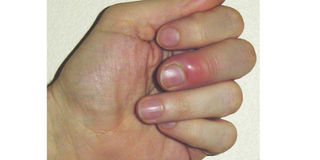Here’s another reason to stop nail biting

It appears to be easy and minor, but if not treated, it can progress into complications that can result in death. Net Photo
According to emedicinehealth.com, paronychias (fingers and toes) are most often caused by common skin bacteria (most commonly staphylococci bacteria) entering the skin around the nail that has been damaged by trauma caused by nail biting, finger sucking, dish washing, or chemical irritants.
Cohens Maliro, a clinical officer at Blessed Medicare Centre in Nansana, explains that although paronychia also affects the toes, it is most common on fingers.
“The infected area becomes swollen and red. It is usually very tender with a yellow-greenish colour which indicates a collection of pus that has formed under the skin of the affected area,” he explains.
In most cases, as the pain progresses, it affects the whole hand or leg giving one sleepless nights.
In diabetic patients, Maliro reveals that one can end up losing their limb or part of it.
Causes
Dr Vincent Karuhanga a medical practitioner explains that other risk factors may include traumas caused during nail trimming and treatment (pedicure or manicure).
“Poor manicure or pedicures normally cause injuries around the nail. And once germs enter, they affect the tissues of the hand or the leg thus causing the painful swelling,” he explains.
Frequent exposure of fingers to water or dirt is also a trigger for paronychia.
“People who deal in garbage collection and farmers who use their hands to sort the grass while digging using their bare hands including people who expose their hands to water regularly are prone to the infection especially when the fingers get injured in the process,” he divulges.
Having HIV or diabetes also makes one more prone to paronychia among other infections due to the lowered immunity.
Myth
You might have heard of the belief that if one points the affected finger at a pit latrine hole, they will be cured.
Needless to say, this is but just a myth. Dr Vincent Karuhanga says the act instead worsens the condition due to contamination from the germs found in the toilet.
Dr Karuhanga discloses that much as it appears to be easy and minor, it can progress into complications if not well attended to thus causing death.
Treatment
Maliro says treatment is done by evacuating or draining pus. The patient can also be given antibiotics and painkillers. And if attended to early, Dr Karuhanga says antibiotics and painkillers can work to curb the pain.
According to emedicinehealth.com a mixture of warm water and liquid antibacterial soap can help. Soak the affected finger or toes three to four times daily for about 15 minutes. The soaking should be done at the first sign of redness around the nail.
However, once any abscess (pus) is visible, one is advised to see doctor for further medication.
Preventive measures
Dr Karuhanga says wearing rubber gloves if one washes dish frequently and in large numbers, farming or garbage collection.
Insist on having proper pedicure or manicure by an experienced service provider, controlling the diabetes in diabetic patients to avoid such risks, ensuring overall good hygiene like washing the hands and the feet as well not biting fingernails




